
Razor
Encyclopedia
A razor is a blade
Blade
A blade is that portion of a tool, weapon, or machine with a cutting edge and/or a pointed tip that is designed to cut and/or puncture, stab, slash, chop, slice, thrust, or scrape animate or inanimate surfaces or materials...
d tool
Tool
A tool is a device that can be used to produce an item or achieve a task, but that is not consumed in the process. Informally the word is also used to describe a procedure or process with a specific purpose. Tools that are used in particular fields or activities may have different designations such...
primarily used in the removal of unwanted body hair through the act of shaving
Shaving
Shaving is the removal of hair, by using a razor or any other kind of bladed implement, to slice it down to the level of the skin. Shaving is most commonly practiced by men to remove their facial hair and by women to remove their leg and underarm hair...
. Kinds of razors include straight razors, disposable razors and electric razors.
While the razor has been in existence since the Bronze Age
Bronze Age
The Bronze Age is a period characterized by the use of copper and its alloy bronze as the chief hard materials in the manufacture of some implements and weapons. Chronologically, it stands between the Stone Age and Iron Age...
, its modern counterpart was invented in the 18th century, and the 1930s saw the invention of electric razors. In the 21st century, the safety razor
Safety razor
A safety razor is a razor that protects the skin from all but the very edge of the blade. These razors reduce the possibility of serious injury, which makes them more forgiving than a straight razor.-Cartridges introduced:...
- electric or not - is most commonly used by both men and women, but other kinds still exist.
History

Bronze Age
The Bronze Age is a period characterized by the use of copper and its alloy bronze as the chief hard materials in the manufacture of some implements and weapons. Chronologically, it stands between the Stone Age and Iron Age...
cultures. These were made of bronze
Bronze
Bronze is a metal alloy consisting primarily of copper, usually with tin as the main additive. It is hard and brittle, and it was particularly significant in antiquity, so much so that the Bronze Age was named after the metal...
or obsidian
Obsidian
Obsidian is a naturally occurring volcanic glass formed as an extrusive igneous rock.It is produced when felsic lava extruded from a volcano cools rapidly with minimum crystal growth...
and were generally oval in shape, with a small tang
Tang (weaponry)
A tang or shank is the back portion of a tool where it extends into stock material or is connected to a handle as on a knife, sword, spear, arrowhead, chisel, screwdriver, etc...
protruding from one of the short ends."Even further away in time, during the Bronze Age, we now have evidence of people taking care of their appearance. This leaf-shaped bronze razor was found near Bidford on Avon and is one of only a few of this type of Bronze Age razor to be found in this country."
Various forms of razors were used throughout history, which are different in appearance but similar in use to modern straight razors. In prehistoric times clam shells, shark's teeth, and flint were sharpened and used to shave with. Drawings of such blades were found in prehistoric caves. Some tribes still use blades made of flint to this day. Excavations in Egypt have unearthed solid gold and copper razors in tombs dating back to the 4th millennium BC. The Roman historian Livy reported that the razor was introduced in ancient Rome in the 6th century BC. by legendary king Lucius Tarquinius Priscus. Priscus was ahead of his time because razors did not come to general use until a century later.
The first modern straight razor complete with decorated handles and hollow ground blades was constructed in Sheffield
Sheffield
Sheffield is a city and metropolitan borough of South Yorkshire, England. Its name derives from the River Sheaf, which runs through the city. Historically a part of the West Riding of Yorkshire, and with some of its southern suburbs annexed from Derbyshire, the city has grown from its largely...
, in England, the centre of the cutlery
Cutlery
Cutlery refers to any hand implement used in preparing, serving, and especially eating food in the Western world. It is more usually known as silverware or flatware in the United States, where cutlery can have the more specific meaning of knives and other cutting instruments. This is probably the...
industry, in the 18th and 19th centuries. Benjamin Huntsman
Benjamin Huntsman
Benjamin Huntsman was an English inventor and manufacturer of cast or crucible steel.-Biography:Huntsman was born the third son of a Quaker farmer in Epworth, Lincolnshire. His parents were Germans who had emigrated only a few years before his birth.Huntsman started business as a clock, lock and...
produced the first superior hard steel grade, through a special crucible
Crucible
A crucible is a container used for metal, glass, and pigment production as well as a number of modern laboratory processes, which can withstand temperatures high enough to melt or otherwise alter its contents...
process, suitable for use as blade material in 1740. Huntsman's process was adopted by the French sometime later; albeit reluctantly at first due to nationalist sentiments. The English manufacturers were even more reluctant than the French to adopt the process and only did so after they saw its success in France. Sheffield steel, a highly polished steel, also known as Sheffield silver steel' and famous for its deep gloss finish, is considered a superior quality steel and is still used to this day in France by such manufacturers as Thiers Issard
Thiers Issard
Thiers Issard or Thiers Issard Sabatier is a French cutlery manufacturer; they are one of a number of companies using the Sabatier name. It exports a wide range of knives and straight razors to approximately thirty countries. They are viewed as one of the top cutlery firms in Europe...
.
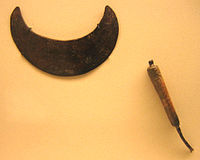
Solingen
Solingen is a city in North Rhine-Westphalia, Germany. It is located on the northern edge of the region called Bergisches Land, south of the Ruhr area, and with a 2009 population of 161,366 is the second largest city in the Bergisches Land...
, Germany produced a variety of razors.
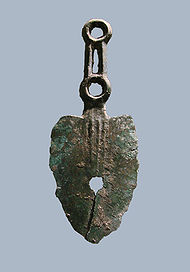
Barber
A barber is someone whose occupation is to cut any type of hair, and to shave or trim the beards of men. The place of work of a barber is generally called a barbershop....
s were specially trained to give customers a thorough and quick shave, and a collection of straight razors ready for use was a common sight in most barbershops. Barbers still have them, but they use them less often.
Straight razors eventually fell out of fashion. Their first challenger was manufactured by King C. Gillette
King C. Gillette
King Camp Gillette was an American businessman popularly known as the inventor of the safety razor, although several models were in existence prior to Gillette's design...
: a double-edged safety razor with replaceable blades. Gillette's idea was the use of the "loss leader
Loss leader
A loss leader or leader is a product sold at a low price to stimulate other profitable sales. It is a kind of sales promotion, in other words marketing concentrating on a pricing strategy. A loss leader is often a popular article...
" concept, in which the razors were sold at a loss, but the replacement blades earned a high margin and provided continuous sales. They were immensely successful due to advertising campaigns and slogans denigrating the straight razor's effectiveness and questioning its safety.
These new safety razors did not require any serious tutelage to use. The blades were extremely hard to sharpen, and were meant to be thrown away after one use, and rusted quickly if not discarded. They also required a smaller initial investment, though they cost more over time. Despite its long-term advantages, the straight razor lost significant market share. And as shaving became less intimidating and men began to shave themselves more, the demand for barbers providing straight razor shaves decreased.
Around 1960, stainless steel
Stainless steel
In metallurgy, stainless steel, also known as inox steel or inox from French "inoxydable", is defined as a steel alloy with a minimum of 10.5 or 11% chromium content by mass....
blades which could be used more than once became available, reducing the cost of safety-razor shaving. The first such blades were made by the Wilkinson
Wilkinson Sword
Wilkinson Sword is a brand name for companies that make gardening tools and razors. Wilkinson Sword's origins are in the manufacture of swords. The company was founded in London in 1772. The brand is currently owned by Energizer Holdings. Past product lines have included guns, bayonets, and other...
firm, famous maker of ceremonial swords, in Sheffield. Soon Gillette, Schick
Schick
Schick may refer to:* Schick , a well-known brand of safety razor* Schick Technologies, a major manufacturer of digital X-ray systems for dentists*Schick test a test to determine susceptibility to diphtheriaSchick is the surname of:...
, and other manufacturers were making stainless-steel blades.
These were followed by multiple-blade cartridges and disposable razors. For each type of replaceable blade, there is generally a disposable razor.
In the 1930s, electric razors became available. These can rival the cost of a good straight razor, although the whole straight-razor shaving kit can exceed the cost of even an expensive electric razor.
Straight razors
Straight razors with open steel blades, also commonly known as cut-throats, were the most commonly used razors before the 20th century. However, they are now chiefly used by barberBarber
A barber is someone whose occupation is to cut any type of hair, and to shave or trim the beards of men. The place of work of a barber is generally called a barbershop....
s.
Straight razors consist of a blade sharpened on one edge. The blade can be made of either stainless steel, which is slower to hone and strop, and holds an edge longer, or high carbon steel, which hones and strops quickly, but has a less durable edge. At present, stainless-steel razors are harder to find than carbon steel, but both are still in production.
The blade rotates on a pin through its tang between two protective pieces called scales: when folded into the scales, the blade is protected from damage, and the user is protected from injury. Handle scales are made of various materials, including mother-of-pearl, celluloid, bone, plastic and wood. They were once made of ivory
Ivory
Ivory is a term for dentine, which constitutes the bulk of the teeth and tusks of animals, when used as a material for art or manufacturing. Ivory has been important since ancient times for making a range of items, from ivory carvings to false teeth, fans, dominoes, joint tubes, piano keys and...
, but this has been discontinued, though fossil ivory is still used occasionally.
Disposable blade straight razors
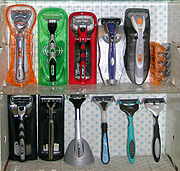
Disposable bladed straights have many of the advantages of straight razors without needing the stropping and honing of ordinary straight razors.
Disposable razors can be resharpened.
Safety razors
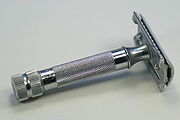
Plane (tool)
A hand plane is a tool for shaping wood. When powered by electricity, the tool may be called a planer. Planes are used to flatten, reduce the thickness of, and impart a smooth surface to a rough piece of lumber or timber. Planing is used to produce horizontal, vertical, or inclined flat surfaces on...
. In 1875 it was marketed by the Kampfe Brothers as "the best available shaving method on the market that won’t cut a user, like straight steel razors."
In 1901, the American inventor King Camp Gillette
King C. Gillette
King Camp Gillette was an American businessman popularly known as the inventor of the safety razor, although several models were in existence prior to Gillette's design...
, with the assistance of William Nickerson, invented a safety razor with disposable blades. Gillette realized that a profit could be made by selling an inexpensive razor with disposable blades. This has been called the Razor and blades business model, or a "loss leader
Loss leader
A loss leader or leader is a product sold at a low price to stimulate other profitable sales. It is a kind of sales promotion, in other words marketing concentrating on a pricing strategy. A loss leader is often a popular article...
", and has become a very common practice for a wide variety of products.
There are also safety razors that are made of inexpensive materials that are meant to be wholly disposable. One device was invented in 1963 by American entertainer and inventor Paul Winchell
Paul Winchell
Paul Winchell was an American ventriloquist, voice actor and comedian, whose career flourished in the 1950s and 1960s...
.
Electric razors
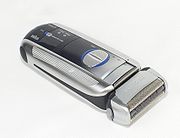
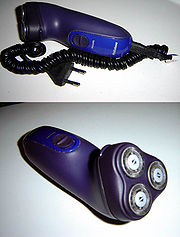
Shaving cream
Shaving cream is a substance that is applied to the face or wherever else hair grows, to provide lubrication and avoid razor burn during shaving. Shaving cream is often bought in a spray can, but can also be purchased in tubs or tubes. Shaving cream in a can is commonly dispensed as a foam or a gel...
, soap, or water. The razor may be powered by a small DC motor
Electric motor
An electric motor converts electrical energy into mechanical energy.Most electric motors operate through the interaction of magnetic fields and current-carrying conductors to generate force...
, which is either powered by batteries
Battery (electricity)
An electrical battery is one or more electrochemical cells that convert stored chemical energy into electrical energy. Since the invention of the first battery in 1800 by Alessandro Volta and especially since the technically improved Daniell cell in 1836, batteries have become a common power...
or mains electricity
Mains electricity
Mains is the general-purpose alternating current electric power supply. In the US, electric power is referred to by several names including household power, household electricity, powerline, domestic power, wall power, line power, AC power, city power, street power, and grid power...
. Many modern ones are powered using rechargeable batteries. Alternatively, an electro-mechanical oscillator driven by an AC-energized solenoid
Solenoid
A solenoid is a coil wound into a tightly packed helix. In physics, the term solenoid refers to a long, thin loop of wire, often wrapped around a metallic core, which produces a magnetic field when an electric current is passed through it. Solenoids are important because they can create...
may be used. Some very early mechanical shavers had no electric motor and had to be powered by hand, for example by pulling a cord to drive a flywheel.
The first electric razor was patented in 1928 by the American manufacturer Col. Jacob Schick
Jacob Schick
Col. Jacob Schick was an American inventor and entrepreneur who patented the first electric razor and started the Schick Dry Shaver, Inc. razor company...
. The Remington Rand
Remington Rand
Remington Rand was an early American business machines manufacturer, best known originally as a typewriter manufacturer and in a later incarnation as the manufacturer of the UNIVAC line of mainframe computers but with antecedents in Remington Arms in the early nineteenth century. For a time, the...
Corporation developed the electric razor further, first producing the Remington brand of razor in 1937. Another important inventor was Prof. Alexandre Horowitz
Alexandre Horowitz
Alexandre Horowitz was a Belgian-born Dutch technical engineer and inventor.Alexandre "Sacha" Horowitz was born in 1904 in Antwerp, to parents of East-European Jewish heritage, and lived from 1914 in The Netherlands until his death in 1982...
, from Philips
Philips
Koninklijke Philips Electronics N.V. , more commonly known as Philips, is a multinational Dutch electronics company....
Laboratories in the Netherlands
Netherlands
The Netherlands is a constituent country of the Kingdom of the Netherlands, located mainly in North-West Europe and with several islands in the Caribbean. Mainland Netherlands borders the North Sea to the north and west, Belgium to the south, and Germany to the east, and shares maritime borders...
, who invented the very successful concept of the revolving (rotary) electric razor. It has a shaving head consisting of cutters that cut off the hair entering the head of the razor at skin level. The major manufacturers introduce new improvements to the hair cutting mechanism of their products each few years. Each manufacturer sells several different generations of cutting mechanism at the same time, and for each generation, several models with different features and accessories to reach various price points. The improvements to the cutting mechanisms tend to 'trickle-down' to lower priced models over time.
Early versions of electric razors were meant to be used on dry skin only. Many recent electric razors have been designed to allow for wet/dry use, which also allows them to be cleaned using running water or an included cleaning machine, reducing cleaning effort. Some patience is necessary when starting to use a razor of this type, as the skin usually takes some time to adjust to the way that the electric razor lifts and cuts the hairs. Moisturizers designed specifically for electric shaving are available.
Some modern styles of electric hair clippers include bulk hair clippers, which are used to remove a bulk of the hair being shaved; main hair clippers, on which guards are attached to achieve a perfect length all over the head; and mini clippers, which are used to trim the edges of the haircut.
Battery-powered electric razors
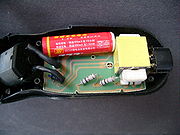
Electric shock
Electric Shock of a body with any source of electricity that causes a sufficient current through the skin, muscles or hair. Typically, the expression is used to denote an unwanted exposure to electricity, hence the effects are considered undesirable....
).
Some models, generally marketed as "travel razors" (or "travel shavers"), use removable rechargeable or disposable batteries, usually size AA
AA battery
An AA battery is a standard size of battery. Batteries of this size are the most commonly used type of in portable electronic devices. An AA battery is composed of a single electrochemical cell...
or AAA
AAA battery
A triple A or AAA battery is a standard size of dry cell battery commonly used in portable electronic devices. A carbon-zinc battery in this size is designated by IEC as "R03", by ANSI C18.1 as "24", by old JIS standard as "UM 4", and by other manufacturer and national standard designations that...
. This offers the option of purchasing batteries while away from home instead of having to carry a compatible charging device.
Wet/dry razors, designed to allow use with soap and water, are exclusively of the battery-operated type (for obvious reasons of electrical safety).
Electric shavers are generally regarded as the greenest solution to men's grooming by sheer virtue of the longevity of the battery life, and the fact that one does not use any water in the process.
Other razors

Bread
Bread is a staple food prepared by cooking a dough of flour and water and often additional ingredients. Doughs are usually baked, but in some cuisines breads are steamed , fried , or baked on an unoiled frying pan . It may be leavened or unleavened...
production to slash the surface of an unbaked loaf; in this usage, they are referred to using the French word lame
Lamé (kitchen tool)
A lame is a double-sided blade used to slash the tops of bread loaves in artisan baking. A lame is used to score bread just before the bread is placed in the oven...
.

